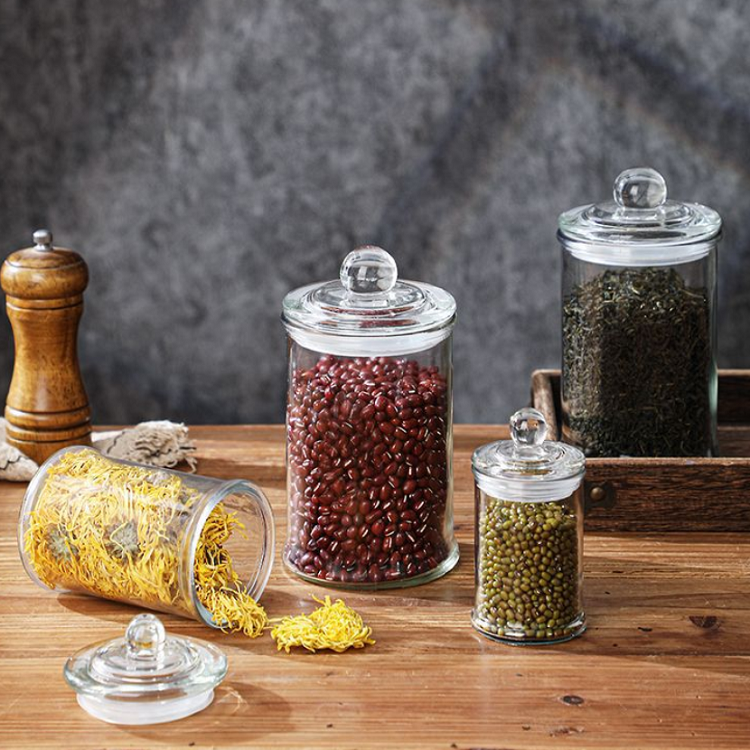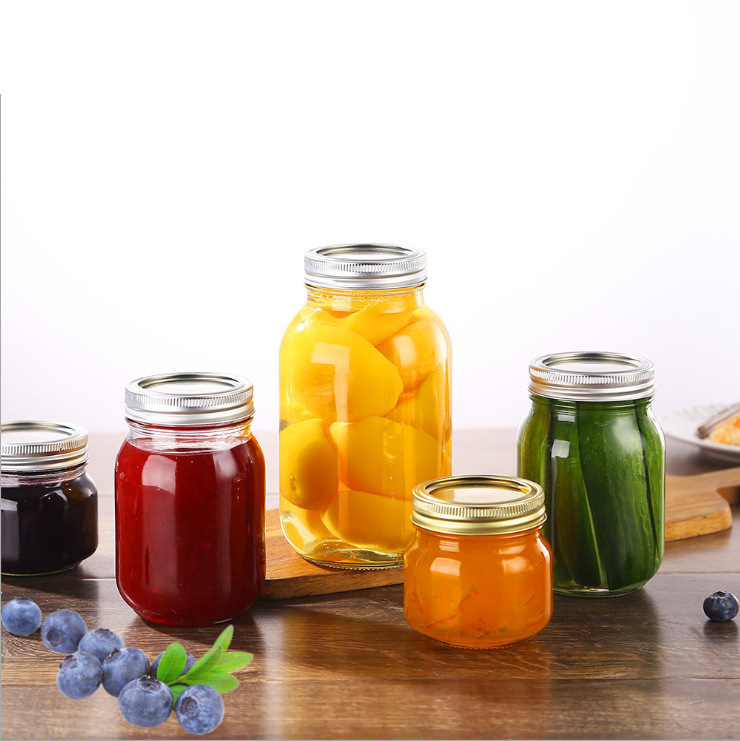Can You Freeze Food in Glass Jars? The Ultimate Guide to Freezing in Glass
03-11-2025
This article explains everything you need to know about freezing food in glass jars. It addresses common concerns, provides step-by-step instructions, and highlights the benefits of using glass over other materials. If you're looking for a safe, sustainable, and efficient way to freeze your food, this guide is worth reading.
Can You Freeze Food in Glass Jars?
Yes, you absolutely can freeze food in glass jars! Many people are hesitant, worried about the glass cracking or breaking. However, with the right precautions, freezing in glass is perfectly safe and offers several advantages. It's a great way to reduce plastic use, store food efficiently, and keep your food fresh.
Glass is a non-porous material, which means it won't absorb odors or flavors from your food. It's also easy to clean and sterilize, making it a hygienic choice for food storage. Plus, seeing your frozen goodies clearly through the glass makes meal planning easier.
Why Do Glass Jars Sometimes Break in the Freezer?
The main reason jars break in the freezer is due to the expansion of liquids as they freeze. When water freezes, it expands by about 9%. If a jar is filled to the brim with liquid, this expansion has nowhere to go, putting pressure on the glass and potentially causing it to crack or shatter.
Another factor is thermal shock. Rapid temperature changes can stress the glass, making it vulnerable to breakage. For example, placing a hot jar directly into the freezer, or taking a jar out of the freezer and immediately running it under hot water, can cause the glass to crack. Glass actually shrinks a little when it’s cooled and expands a little when heated and if pressure is applied it tends to crack.Although it’s rigid and solid it still moves a little, and extreme temperature changes can make it crack.
What Kind of Glass Jars Are Best for Freezing?
The best jars for freezing are those made of tempered glass, specifically designed for freezing. Tempered glass is much stronger and more resistant to thermal shock than regular glass. Look for jars labeled as "freezer-safe" or "freezer jars."
Here's a quick guide to choosing the right glass jar:
- Tempered Glass: This is your best bet. It's specifically treated to withstand extreme temperatures.
- Wide-Mouth Jars: These are easier to fill and empty, especially with solid or semi-solid foods. The wide neck also reduces the risk of breakage, as the contents freeze, it has space to expand.
- Straight-Sided Jars: Jars with tapered sides (wider at the top than the bottom) are also a good choice, as they allow for expansion. Avoid jars with shoulders (a curve inward at the top).
- Avoid Store bought jars: like peanut butter jars or sauce jars.
- Canning Jars: (Mason jars) are excellent, as many are made of tempered glass and designed for both canning and freezing.
- Weck Jars: Known for their stylish design and airtight seals, Weck jars are also sometimes use and a good option for freezing, provided they are made of tempered glass.

How Much Headspace Should I Leave When Freezing in Glass Jars?
Headspace is crucial when freezing liquids or foods with high water content. Head space is the empty space at the top of the jar, between the top of the food and the lid. This space allows the food to expand as it freezes without putting pressure on the glass.
Here's a general guideline for headspace:
- Liquids (soups, broths, sauces): Leave at least 1-2 inches of headspace.
- Semi-Solids (stews, mashed foods): Leave about 1 inch of headspace.
- Solids (fruits, vegetables): Leave about ½ inch of headspace.
It's always better to leave a little extra head space than to risk overfilling the jar.
Step-by-Step Guide: How to Freeze Food in Glass Jars Without Breaking Them
Freezing food in glass jars is easy if you follow these steps:
- Choose the Right Jar: Select a freezer-safe glass jar, preferably made of tempered glass, with a wide mouth or straight sides.
- Cool Food Completely: Never put hot food directly into a glass jar and then into the freezer. Let the food cool completely in the fridge before freezing.
- Fill the Jar, Leaving Headspace: Fill the jar with the cooled food, leaving the appropriate amount of headspace (1-2 inches for liquids, 1 inch for semi-solids, ½ inch for solids).
- Seal the Jar Loosely: Place the lid on the jar, but don't tighten it completely. This allows air to escape as the food freezes and expands.
- Freeze: Place the jar in the freezer. Once the contents are frozen solid (usually after a few hours or overnight), you can tighten the lid completely.
- Label and Date: Always label your jars with the contents and the date. This helps you keep track of what's in your freezer and how long it's been there.

How to Safely Defrost Food Frozen in Glass Jars
Proper defrosting is just as important as proper freezing. Never try to rush the thawing process, as rapid temperature changes can cause the glass to break.
Here are the safest ways to defrost food frozen in glass jars:
- Refrigerator: The best method is to transfer the frozen jar from the freezer to the fridge and let it thaw slowly overnight.
- Cold Water Bath: If you need to defrost something more quickly, place the sealed jar in a bowl of cold water. Change the water every 30 minutes to keep it cold. Don't use hot water. Never pour cold water into the jar when you’re defrosting.
- Microwave (with caution): If your jar is microwave-safe (and the lid is removed), you can use the defrost setting on your microwave. Be very careful and defrost in short intervals, stirring frequently to ensure even thawing. This method is generally not recommended for glass, as it can cause uneven heating and increase the risk of breakage.
Never place a frozen glass jar directly on a countertop at room temperature to thaw, or put a frozen jar directly to hot water. The sudden changes in temperature is the easiest way to stop glass from expanding and cause break.
What Types of Food Can I Freeze in Glass Jars?
You can freeze a wide variety of foods in glass jars, including:
- Soups and Broths: Glass jars are perfect for storing and freezing soups, stews, and broths.
- Sauces: Homemade or leftover sauces freeze beautifully in glass jars.
- Fruits and Vegetables: Blanch vegetables before freezing to preserve their color and texture.
- Cooked Grains: Rice, quinoa, and other cooked grains can be frozen in portion-sized jars.
- Beans and Legumes: Cooked beans and lentils freeze well and are easy to thaw for quick meals.
- Baby Food: Glass jars are a safe and convenient way to store homemade baby food.
- Leftovers: Freeze individual portions of leftovers for easy lunches or dinners.
- Prepared Food: Freezing your surplus of prepared food in glass bottles is a great way to be prepared.
- Smoothies: You may use glass jars for freezing premade smoothies
Are There Any Foods I Shouldn't Freeze in Glass Jars?
While glass jars are versatile, there are a few things you should avoid freezing in them:
- Carbonated Beverages: The pressure from carbonation can cause the jar to explode in the freezer.
- Large Whole Fruits or Vegetables with High Water Content: Items like whole melons or heads of lettuce can become mushy and lose their texture when frozen. It's better to cut them into smaller pieces before freezing.
*Foods in store bought jars such as sauce jars, or peanut butter jars should not be stored in the freezer.
Is Freezing in Glass Better Than Using Plastic Containers?
Freezing in glass offers several advantages over using plastic containers or plastic freezer bags:
| Feature | Glass Jars | Plastic Containers / Bags |
|---|---|---|
| Durability | Durable and long-lasting; can be reused many times. | Can become brittle and crack over time, especially with repeated freezing and thawing. |
| Safety | Non-porous; doesn't leach chemicals into food. BPA-free. | Some plastics can leach chemicals into food, especially when heated or when storing acidic or fatty foods. Concerns about BPA and phthalates. |
| Taste & Odor | Doesn't absorb odors or flavors. | Can absorb odors and flavors, affecting the taste of the food. |
| Cleaning | Easy to clean and sterilize; dishwasher-safe. | Can be difficult to clean thoroughly; may stain or retain odors. |
| Sustainability | Eco-friendly; reusable and recyclable. | Contributes to plastic waste; single-use bags are particularly problematic. |
| Visibility | Transparent; easy to see contents. | Can be difficult to see contents, especially in opaque containers or bags. |
| Freezer Burn | Provides a good airtight seal, reducing the risk of freezer burn if used correctly. | More susceptible to freezer burn if not sealed properly. Bags are prone to punctures. |
| Cost | Initially more expensive than plastic, but more cost-effective in the long run due to reusability. | Cheaper upfront cost, but may need to be replaced more frequently. |
| Ziploc | Glass jars are more durable than ziploc bags, they are also safer. | Ziploc bags can contribute to plastic waste. |
While glass jars may require a slightly larger initial investment, their durability, safety, and environmental benefits make them a superior choice for long-term food storage and freezing.
Where Can I Buy High-Quality Glass Jars for Freezing?
As a company owner and procurement officer in the USA, you have several options for sourcing high-quality glass jars for your business, Mark.
-
Direct from Chinese Manufacturers (Like Us!):
- Contact Person: Allen
- Country: China
- Business Model: B2B, Factory with 7 production lines
- Main Export Countries: USA, North America, Europe, Australia
- Product Features: High-quality glass materials, customizable designs, various sizes and shapes, durable and leak-proof, aesthetically pleasing, compliant with international safety standards. We are experienced with the problems you are facing and ensure there will be: efficient communication, minimal shipment delays, and valid certifications.
- Promotion Channels: Exhibitions, and online presence.
- Why Choose Us?: You can purchase directly from a manufacturer like us, which can offer significant cost savings compared to buying from distributors. We specialize in glass jars and can offer customized solutions to meet your specific needs, including marijuana glass jar, cannabis glass jar, weed glass jar. We have a proven track record of exporting to the USA and other major markets, ensuring smooth logistics and compliance with all relevant regulations.
- Internal Link: Explore our wide range of diffuser bottles and find the perfect fit for your needs! Also, we have a great selection of reed diffuser bottles. Check out our luxury diffuser bottles.
-
Online Marketplaces: Websites like Alibaba, DHGate and Global Sources connect you with numerous Chinese suppliers. However, be diligent in vetting suppliers to ensure quality and reliability. Look for verified suppliers with good reviews and a history of successful transactions.
-
Attend Trade Shows and Exhibitions: Industry-specific trade shows, both in the USA and internationally, provide opportunities to meet suppliers face-to-face, see their products firsthand, and negotiate deals. This aligns with your preference for finding suppliers through exhibitions.
-
Online Directories:
- ThomasNet: A comprehensive directory of North American industrial suppliers.
- IndustryNet: Another directory listing industrial suppliers, with a focus on US manufacturers.
-
Wholesale Distributors:
- Specialty Bottle: A US-based distributor offering a wide range of glass bottles and jars.
- Berlin Packaging: A large packaging supplier with a global presence, offering glass containers.
- Uline: A distributor of packaging and industrial supplies, including glass jars.
- Note, I’ve frozen many kinds of food with great success using these suppliers.
Remember, Mark, I understand your main purchasing locations are China and Vietnam. Working directly with a Chinese factory like ours can provide the most competitive pricing and customization options, directly addressing your profit model of purchasing low-cost containers.
Key Takeaways for Freezing Food in Glass Jars:
- Use tempered, freezer-safe glass jars.
- Always leave headspace for expansion.
- Cool food completely before freezing.
- Seal jars loosely until contents are frozen solid.
- Thaw frozen jars slowly in the refrigerator or cold water.
- Avoid extreme temperature changes.
- Glass is a safer, more sustainable alternative to plastic.
- Source your jars from reputable suppliers, like us, Allen, in China.
- Don't overfill the jars to ensure no break in the freezer.
- Make sure the jars you choose do not have jar lids that are lose.
- Jars without shoulders are safer to use.








